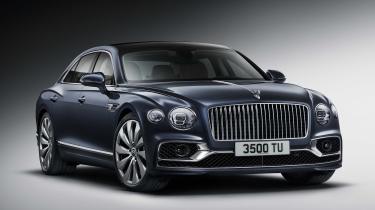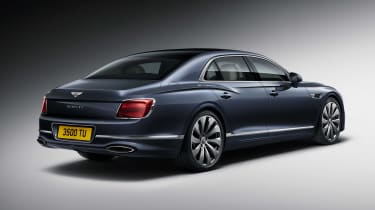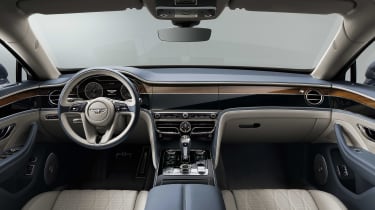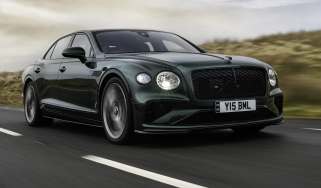All-new 2019 Bentley Flying Spur promises sharpest driving experience yet
New platform, more power and four-wheel steering for Bentley’s Flying Spur supersaloon
Bentley has released full details of its third-generation Flying Spur, with the aim of providing greater agility and entertainment for the driver without sacrificing any of the luxury and comfort that buyers demand.
Visually the Flying Spur is a more cohesive and confident design than before. The wheelbase has increased by 130mm but overall length is up by only 80mm, putting more metal between the wheels and decreasing the size of the overhangs. The front grille is not only larger than before but more upright and with more vertical vanes for greater presence, while there is a pronounced curve in the flanks over the wheelarches, reducing the visual bulk. The body-in-white itself is created from superformed aluminium panels, which Bentley says are the largest in the automotive industry, and contribute to the bodyshell weighing 38kg less than before.
> New Bentley Continental GT review - has Bentley's new GT been worth the wait?
In addition, the 6-litre twin-turbocharged W12 engine is carried across from the Continental GT, delivering 626bhp and 664lb ft of torque to give the Flying Spur a top speed of 207mph and a 0-62mph time of only 3.8sec. It shares the cylinder deactivation and eight-speed dual-clutch gearbox with the Continental GT too, but the Flying Spur gets a new dual-mass flywheel designed for increased cabin insulation.
The Flying Spur shares the MSB-F platform with the Continental GT, as well as with the Porsche Panamera, and that brings with it the technical enhancements that push it beyond the capabilities of the outgoing car. The 48V architecture means the Flying Spur enjoys the advantages of the Dynamic Ride system and Active All-Wheel Drive, which sends drive to the rear wheels unless a loss of grip is detected, but it is also the first Bentley to receive All-Wheel Steering. The system turns the rear wheels in the opposite direction to the front for greater manoeuvrability at low speeds, turning them in the same direction at higher speeds for increased stability.
Active Torque Vectoring also features for the first time on a Flying Spur, working in tandem with the four-wheel-drive system. The amount of torque sent to the front wheels on demand is up to approximately 38 per cent in Comfort mode, but this is reduced to a maximum of 17 per cent in Sport mode with torque managed across each axle by the vectoring system, as well as braking an inside wheel when driving out of a corner.
> Click here for our review of the new Bentley Bentayga Speed
The Flying Spur also gains the latest-generation driver aids thanks to its modern architecture, with traffic assist, city assist, blind spot warning and night vision all available. The centre console houses a 12.3-inch rotating HD touchscreen, with a digital instrument display providing a much-needed update in terms of infotainment systems. Three audio systems are also available, all the way up to a 2220W, 19-speaker Naim for Bentley package, while the redesigned cabin features a new ‘wing’ design, the option of dual veneers and 3D-quilted leather door inserts for the first time.
Prices are yet to be confirmed but expect a starting price in excess of £160,000 for the W12 model, with V8 and PHEV versions to follow. Sales are expected to commence in the autumn of 2019 with UK deliveries into 2020.






